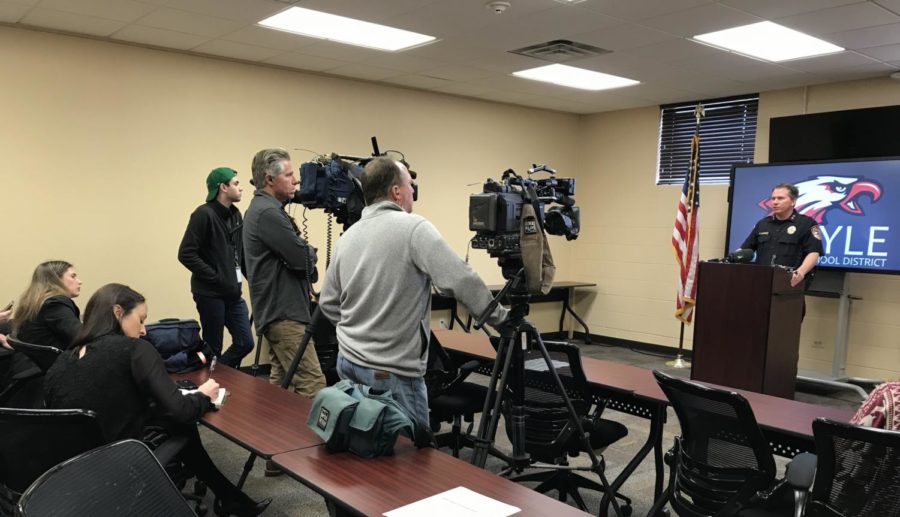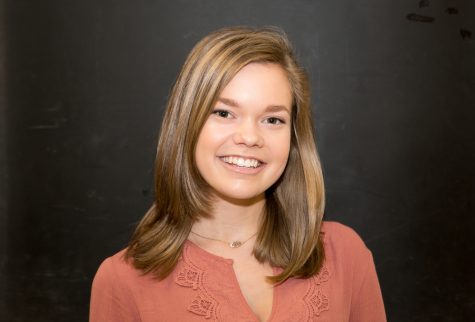Press Conference Offers Deeper Look Into Gun Policy
AISD Police Chief Paul Cairney addresses media about the district’s armed staff policy at a press conference at the administration building on Thursday in Argyle, TX. (Miranda Downe / The Talon News)
March 5, 2018
To address misconceptions of the armed staff policy after its national and statewide coverage, and to provide a deeper understanding of the policy’s practice, AISD Police Chief Paul Cairney and Superintendent Dr. Telena Wright spoke to media at a press conference Thursday in the administration building.
“We don’t want anything to happen here, and that’s one of the reasons why we’re willing to go public with it,” Cairney said. “We want to make sure that anybody that might think about doing something here [knows they are] going to be confronted by an armed individual. We hope that what we do is acting as a very solid deterrent.”
Among reporters from CBS 11, channel four, UNT, NBC Universal, and other news outlets, Dr. Wright first pointed to the policy’s beginnings in 2014 that originated from a community forum in the high school auditorium.
“After that community forum that night, I could see that the community was going to be behind the concept of armed staff,” Wright said. “I could see that by-and-large the community members who were there that night wanted protection for their sons and daughters.”
The armed staff policy ultimately won majority approval from the school board’s consideration comparing an armed staff to Student Resource Officers (SROs), or the option of a Texas School Marshall Program. An armed staff offers a quicker response time, as teachers may carry concealed weapons on their person rather than keep them locked away in a classroom, and a shorter training period, omitting arrest and apprehension training that Marshall’s are required to obtain within their 80 hour course.
“In a situation that we might have at any school where there’s an armed intruder, that instance can be over in three to five minutes,” Cairney said. “It’s a very, very quick incident, and we know that in situations like that, every second counts. We think that it’s much more effective for our armed staff members to have a weapon on them at all times and can immediately respond.”
The training program for staff members can last between three-and-a-half to five days, depending on their firearms background, and ends with a ‘final exam’ in a school-like room that forces potential armed candidates to face ‘shoot or don’t shoot’ scenarios in the midst of gunfire.
“This is as close as we can get to replicating actual combat, an actual firefight,” Cairney said. “Now, as they’re going through it, they know what it feels like to be in that environment. It’s a very stringent and intense program that we put them through, but that’s on purpose because, of course, if it were to really happen, we want to make sure they can handle the pressure.”
Staff must also pass psychological testing to determine their temperament, aptitude to over or under react, and response speed and work at the district for at least a year before they are considered for a position.
“We keep [armed staff identities] a secret, and I think that’s part of the effectiveness of the program,” Cairney said. “You can walk through our campus at any given time and pass a handful of teachers that are carrying, and you’re never going to know it. It’s fascinating when [the students] tell me who they think is carrying, and I can guarantee nobody will ever be able to guess who the people are that are carrying.”
Cairney stressed the fact that all staff members that carry receive no stipend pay and are volunteers, whose identities must be kept secret in accordance with state law to protect them from becoming targets themselves.
“I wish I could tell you who they [are] because our armed staff members deserve a lot of credit for what they have taken on, for what they have volunteered to do,” Cairney said. “If there is a sound of gunfire, they go directly to it. They don’t wait for backup.”
That responsibility to go toward the gunfire and react quickly comes into question after the shooting in Florida where a police officer failed to jump to action.
“The key of having the armed staff program is if I’m not in that building, it’s still going to take a few minutes for me to get there,” Cairney said. “Those few minutes are still absolutely critical. And that’s why we need that as well as a part of our whole scheme, to make sure that we can address the issue immediately and not wait for law enforcement to arrive.”
In addition to the armed staff program, the district will add a third full-time officer to extend security in the Fall of 2019 when the new elementary campus opens in the Harvest community.
“As dynamics change, we want to stay on top of it,” Cairney said. “We want to make sure we’re always up to speed with the best response capabilities and tactics that we absolutely can.”







